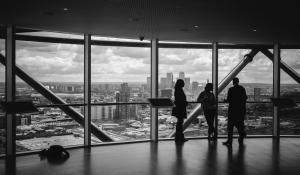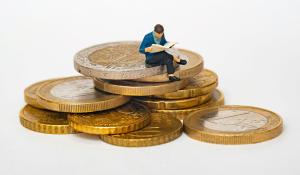
The sound of the rain pattering on your roof during a summer storm may also be the sound of a missed opportunity—for you and for the planet. Increasingly, homeowners are discovering the benefits of “green roofing”—or covering a flat section of their rooftops with an expanse of small plants growing in a few inches of engineered soil.
In addition to reducing household cooling and heating costs and extending the life of the roof, green roofs also assist with a host of urban environmental problems—they filter stormwater, help to cool and clean city air, and help prevent flooding. And, they add a cheerful touch of greenery that can be appreciated by those who look down on the roof from taller homes and buildings.
Green roofs defined
The design of green roofs are much more than meets the eye—from above, you might see an expanse of growing media or pebbles dotted with patches of small plants. But the real action takes place in the layers between the leafy surface and the roof.
An extensive green roof is placed like a rug over a swath of roof on which people don’t walk much. Moving from bottom to top through a slice of green roof, you’d find a special membrane covering the roof itself. This bottom layer is either a hot-applied rubberized asphalt or a cold-applied layer of synthetic rubber, which, in combination with a root-repellant material, is designed to block moisture and roots from damaging the roof. A drainage layer of pebbles or a geo-composite drain mat lies on top of the membrane; a filter cloth lies atop the drainage layer. The top, visible layer of a green roof is the several inches of a growing medium, which hosts a crop of hardy low-lying plants, like sedum, chives, talinum, and delosperma. These sandwiched materials provide a natural sponge and filter for rainwater, and protection for the rooftop itself.
An extensive green roof is super low-maintenance. The drought-resistant plants used on these green roofs do fine with rainwater and don’t need supplemental watering after establishment, except in extreme conditions. They usually require weeding once or twice a year.
An “intensive” green roof, which has several feet of growing media and much larger plants.
Benefits of green roofing
Green roofs can save homeowners on cooling and heating costs. The leafy cover of a green roof helps cool the air through evaporation, by providing shade, and by forming a more lightly colored surface than the dark roof underneath. In the summer, a house wearing a green roof can keep cooler than a house with heat-absorbing black roof tiles—thereby using less energy on air conditioning. During winter, the insulation provided by the green roof can also help lower heating costs.
A green roof can help to reduce noise in your home, and the protection offered by a green roof may more than double the life of your home’s existing roof. Some homeowners with new roofs topped with green roofing have been able to negotiate especially long 20-year warranties for this reason, says Linda Velazquez, editor of Greenroofs.com.
Benefits for the planet
Green roofs are also a great solution for the environment. Urban waterways become polluted in part because falling stormwater runs off nonporous sidewalks, roofs, and parking lots and directly into area waterways. Green roofs can absorb up to 90 percent of the rain that falls onto them. Their layers filter that water, removing pollutants before the water continues on its way to streams and rivers. By delaying the rush of stormwater into sewers after a rainfall, widespread green roofs can also help prevent flooding. The plantings on green roofs help absorb airborne toxins and carbon dioxide as they photosynthesize, and can provide welcome habitat for birds.
In the summer, a home with a green roof can keep city air cooler. The expanse of dark surfaces in heavily-developed areas are to blame for the “urban heat island effect,” in which many cities are two to ten degrees Fahrenheit warmer than the surrounding countryside, exacerbating smog (which forms more readily at higher temperatures) and driving up air conditioning costs and energy use.
The City of Chicago has undertaken a massive investment in greenroofing, beginning with a 20,000 square foot rooftop garden on Chicago City Hall, with the goal of reducing the heat island effect in America’s third largest city. An energy study estimated peak demand would be cut by the equivalent of a small nuclear power plant if all of Chicago’s roofs were greened, according to Weston Design Consultants, because more Chicagoans could give their air conditioners a rest.
Is a green roof right for you?
Would your home or building be a good candidate for a green roof? If your roof is flat or no more than 30 degrees sloped, and in a sunny location relatively unshaded by trees, then you might be able to greenroof your home. Because green roofs weigh more than conventional roofing, you will also need to ensure that your home can support the added weight of the soil after a rainstorm—about 20 pounds per square foot. (Check out the rebate offered by DC's Department of Energy and the Environment, to explore whether your home is “green roof ready.”) The cost of residential greenroofing generally ranges from $12–$35 per square foot, and should be installed by a professional. Look for an installer who brings both green roof experience and training from Green Roofs for Healthy Cities, which is has a Green Roof Professional accreditation.
If you’ve been thinking about going solar at home, you may be wondering which is better—greenroofing or solar panels? Well, homeowners may not have to choose as studies have shown that photovoltaic (PV) panels can be integrated with greenroofs with results showing reciprocal benefits for both. The cooling effect of the plants are thought to increase the electricity production of solar panels, which are temperature-sensitive and in turn, the shade the panels provide cools plants and soil.
One thing that might drive a decision would be cost, as solar systems can cost from $25,000 to $45,000 and green roofs generally cost around $2,000. But, most solar installations are leased nowadays, meaning that a company will pay for panels and install them, and will charge you per month for the array, generally less than what you already pay for your electric bill (that's why people put in solar, to save money). So if you have a green roof, you may also be able to find a company that would be willing to put an installation on a roof with a green element already, since large, flat roofs are ideal for both.
Next time the summer rain is drumming on your rooftop, decide to put those raindrops—and that space—to better use: cool the air, clean the water, and support plant life with a living green roof.







